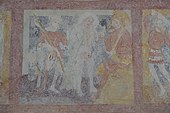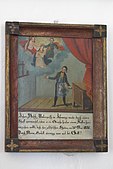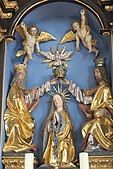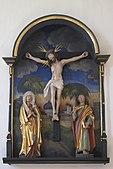St. Maria (Bergkirchen)
The Catholic branch church St. Maria (also Maria Himmelfahrt ) in Bergkirchen , a district of Jesenwang in the Upper Bavarian district of Fürstenfeldbruck , was built around 1400 on the foundations of a Romanesque predecessor church and was given a Baroque style at the end of the 17th century . The church, in which Gothic frescoes have been preserved, is one of the protected architectural monuments in Bavaria.
history
From the early 14th century the church in the hamlet of Bergkirchen was subordinate to the Fürstenfeld monastery , which initiated the construction of the Gothic church around 1400. The church has been the destination of a pilgrimage to Mary since the 15th century . In the course of the baroque transformation of the church, the windows were enlarged and the old wooden ceiling was replaced by a white ceiling. The tower received an onion dome.
After secularization in 1802, the church was supposed to be demolished, but demolition was delayed. In order to secure the preservation of the building, four Jesenwang farmers bought the church in 1810. In 1846 it was acquired by the Jesenwang municipality, who owns it to this day. The last major renovation of the church took place between 2015 and 2018.
architecture
Exterior construction
The bell tower covered with an onion dome stands in the northern corner of the choir . It consists of a square basement and an octagonal structure, which is divided by cornices and glare fields with two nuns' heads each. The bell floor is pierced by slightly pointed sound arcades . A profiled pointed arch portal on the south side of the nave provides access to the church.
inner space
The church is a late Gothic hall building with three window axes . To the east of the single-nave nave , the non-retracted, three-sided closed choir connects seamlessly . The west gallery , which rests on wooden supports, was probably built in the 16th century. Pictures of the Way of the Cross are attached to the gallery parapet. The entire interior is consistently covered by a flat wooden ceiling.
The ground floor of the tower, to which a small pointed arched portal leads and which is now used as a sacristy , is covered with a star vault, the colored version of which was discovered during the restoration and renewed. Several niches have been cut into the walls and an uncleared inscription has been exposed on one side.
Frescoes
During the renovation in 1956/57, a cycle of Gothic frescoes was uncovered, which is dated around 1430. In two rows one on top of the other, five pictures are strung together, depicting scenes from the Passion of Christ. The individual scenes are separated from each other by wide, painted frames. The first picture in the top row shows Jesus and the sleeping disciples on the Mount of Olives, followed by the Judas kiss , the arrest of Jesus and his presentation to Caiaphas , then the flagellation and the crowning of thorns. In the lower row you can see the Carrying of the Cross, the Crucifixion, the Entombment and the Resurrection of Christ. The last scene is badly damaged; perhaps it shows the unbelieving Thomas who puts his fingers in the wound of Jesus.
Votive pictures
The 19 votive plaques on the west wall remind us that St. Mary's Church was once the destination of a pilgrimage. Most of the pictures are from the 18th and 19th centuries. The text of the oldest picture shows the year 1685; possibly the pilgrimage was revived at that time. On the upper part of the picture the Last Supper is shown, below it the donor family.
Furnishing
- The high altar was created in the early 18th century. The altarpiece with the depiction of the crucifixion of Christ and the two thieves bears the signature of the painter Johann Rieger ("JA Riegi").
- In the middle niche of the baroque side altar is the late Gothic group of sculptures of the Coronation of Mary .
- A late Gothic crucifixion group hangs on the south wall of the nave. The background, a painted landscape in which a city fortified with walls and towers is embedded, dates from the 19th or 20th century.
- The pictures of the Way of the Cross on the gallery parapet are dated to the 18th century.
literature
- Georg Dehio: Handbook of German Art Monuments - Bavaria IV - Munich and Upper Bavaria . 2nd edition, Deutscher Kunstverlag, Munich 2002, ISBN 3-422-03010-7 , p. 125.
- Volker Liedke, Peter Weinzierl: District Fürstenfeldbruck (= Bavarian State Office for Monument Preservation [Hrsg.]: Monuments in Bavaria . Volume I.12 ). Karl M. Lipp Verlag, Munich 1996, ISBN 3-87490-574-8 , p. 134 .
- Assumption Day. Bergkirchen near Jesenwang . Municipality of Jesenwang (ed.), Jesenwang 2018.
Web links
Individual evidence
- ↑ List of monuments for Jesenwang (PDF) at the Bavarian State Office for Monument Preservation, monument number D-1-79-130-3
Coordinates: 48 ° 10 ′ 25.5 ″ N , 11 ° 8 ′ 10.9 ″ E















